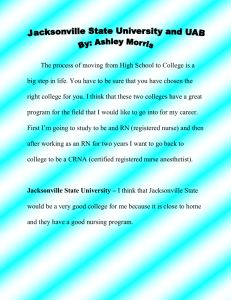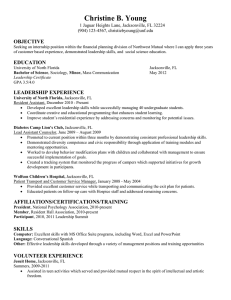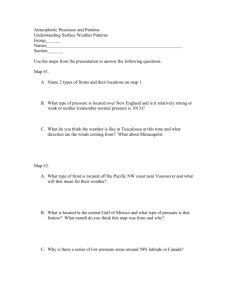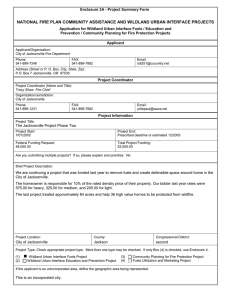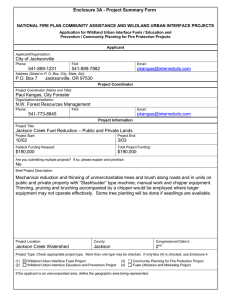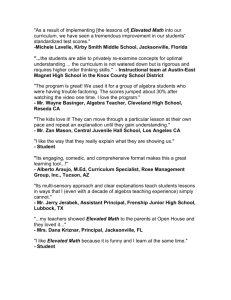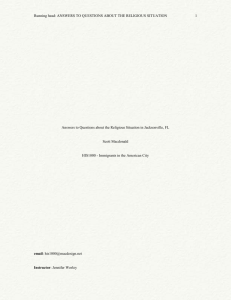169 Enclosure 3A - Project Summary Form
advertisement
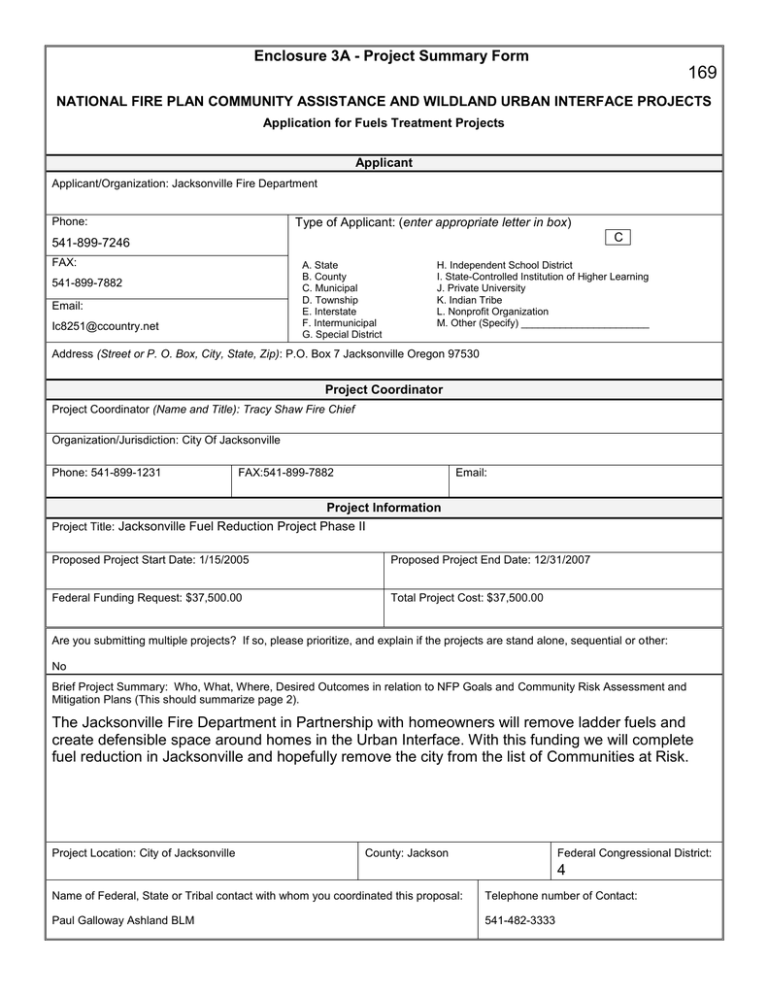
Enclosure 3A - Project Summary Form 169 NATIONAL FIRE PLAN COMMUNITY ASSISTANCE AND WILDLAND URBAN INTERFACE PROJECTS Application for Fuels Treatment Projects Applicant Applicant/Organization: Jacksonville Fire Department Phone: Type of Applicant: (enter appropriate letter in box) C 541-899-7246 FAX: A. State B. County C. Municipal D. Township E. Interstate F. Intermunicipal G. Special District 541-899-7882 Email: Ic8251@ccountry.net H. Independent School District I. State-Controlled Institution of Higher Learning J. Private University K. Indian Tribe L. Nonprofit Organization M. Other (Specify) _______________________ Address (Street or P. O. Box, City, State, Zip): P.O. Box 7 Jacksonville Oregon 97530 Project Coordinator Project Coordinator (Name and Title): Tracy Shaw Fire Chief Organization/Jurisdiction: City Of Jacksonville Phone: 541-899-1231 FAX:541-899-7882 Email: Project Information Project Title: Jacksonville Fuel Reduction Project Phase II Proposed Project Start Date: 1/15/2005 Proposed Project End Date: 12/31/2007 Federal Funding Request: $37,500.00 Total Project Cost: $37,500.00 Are you submitting multiple projects? If so, please prioritize, and explain if the projects are stand alone, sequential or other: No Brief Project Summary: Who, What, Where, Desired Outcomes in relation to NFP Goals and Community Risk Assessment and Mitigation Plans (This should summarize page 2). The Jacksonville Fire Department in Partnership with homeowners will remove ladder fuels and create defensible space around homes in the Urban Interface. With this funding we will complete fuel reduction in Jacksonville and hopefully remove the city from the list of Communities at Risk. Project Location: City of Jacksonville County: Jackson Federal Congressional District: 4 Name of Federal, State or Tribal contact with whom you coordinated this proposal: Telephone number of Contact: Paul Galloway Ashland BLM 541-482-3333 Enclosure 3A (Page 1 of 3) - Project Narrative Description Applications for funding must include a narrative response that describes the proposal. Please do not submit responses longer than one page, single space, 12-pitch font. Describe project including, but not limited to: project location (e.g., Watershed, Address neighboring community) these items as applicable: anticipated outcomes project relationship to the community risk assessment and mitigation plan amount or extent of actions (acres, number of homes, etc.) community partners and their project timeline and matching or contributed funds role(s) proponent’s ability to complete project For this project, explain the level of cooperation, coordination or strategic planning, through a “Local Coordination Group.” If you haven’t worked with a local coordination group, why not? The Goal: Our Goal is reduce the threat and spread of wildfire in the Jacksonville Urban Interface. To eventually remove Jacksonville from the Federal list of Cities at risk. Objective: To receive $37,800.00 to fund the removal and/or reduction of ladder fuels and remove all unwanted brush and debris that would assist in the spread of wildfire in the Urban Interface around the City of Jacksonville. Grant Proposal: The City of Jacksonville is a Historical Town in southern Oregon at this time we have one career person (the Fire Chief) and 21 volunteers. The City is on the Federal Registry for Cites at risk of catastrophic wild fires. Our city is 65% Urban Interface. We have a population of 2,235 citizens with an average age of 48; 28% of our population is over the age of 62 and the average median value of a home is $302,500.00 not to mention the historical value of our business district with most buildings built at the turn of the century. This places at risk 672 homes totaling $203,280,000.00 at risk in our wild-land areas. The Plan: If the city of Jacksonville Fire Department is successful in receiving a fuels reduction grant for the year 2005 we would continue with removal of ladder fuels and noxious vegetation to continue our original plan submitted to the Oregon Department of Forestry in 2001.Our original plan had three phases that would include all areas of the City that contain Urban Interface homes. Phase one has been completed and with the funding mentioned above we would proceed with phase two. Phase two included Third Street to the City limits, Oregon Street to the City Limits, and the areas around ParA-Dice road and Mary-Ann Drive. The process would involve the homeowner, the contractor, and the Jacksonville Fire Department. We would hold public meetings (Fire Wise Workshops etc.) and go over our plan. Our plan is to have a contractor clear the land and provide defensible space for approximately 100 homes on the south and West borders of Jacksonville. North and East were completed in phase one. These homes rang from a standard city lot to 2 acres. We would ask the contractor to pile near road and driveways. After the cutting and brush is piled we would bid a second contractor to chip the piles and the homeowner would be responsible for the charges. The homeowners would also have the option of removal of chipping the debris themselves. The piles would not be allowed to remain during fire season and all of these stipulations would be by contract. Maintenance: Upon completion of the Urban Interface fuel reduction it is the cities position that the homeowner shall be held accountable for maintenance. Therefore we would enact an ordinance that requires inspection upon complaint, an order to abate, and a fine for failure to comply. Enclosure 3A (Page 2 of 3) - Project Evaluation Criteria Applications for funding must include narrative responses that address the following three criteria. Be sure you address every one briefly, yet thoroughly. Limit your responses to the area provided. 1. Reducing Hazardous Fuels (50 points) A. Describe the community infrastructure that will be protected. B. Explain how the proposal reduces fire behavior in high hazard areas by describing the fuels to be disposed or removed, and the techniques and timing of the treatments. C. How will the proposed treatments be maintained in future years? D. How will you use multi-party monitoring to improve this and future projects? Response: A. The City of Jacksonville has between 60% and 70% Urban Interface properties. Three City reservoirs are in these areas and a major roadway Hwy. 238 runs right through the middle of it connecting the Applegate Valley to the Medford area. Our City is a National Historic Landmark and relies on tourisms as it livelihood a wildfire would devastate our community. Preventing that from happening is paramount. B. We live in some very steep terrain by removing the ladder fuels the fire would remain on the ground and move slowly and could be managed by hand crews. Keeping the fire out of the trees would prevent embers from floating in the air and igniting one of the historic buildings or homes. C. It is our goal to help the homeowner get the property to where they can maintain the property themselves. After that point an ordinance for maintenance would be in place D. We would partner with ODF crews and BLM that patrol our area. We would provide them a contact to report any property that was in need of attention then we would visit the homeowner and star the process. Enclosure 3A (Page 3 of 3) - Project Evaluation Criteria 2. Increasing Local Capacity (25 points) A. How would the proposal improve or lead to the improvement of the local economy in terms of jobs and sustainable economic activity? B. How many jobs are expected to be created or retained and for how long? (Please distinguish between essentially year-round and seasonal jobs). C. What tools and skills will be gained or utilized as a result of this project? D. Will biomass be utilized; if so, in what manner and how much? Response: A. This project will go to bid and provide income to the seasonal labor force that fights fires in the summer months. B. It is my feeling this project will take six to twelve individuals to do this project. The project would last anywhere from 3-6 months each year. C. This project would require a supervisor; a chin saw operator and 4-6 laborers. Brush and debris will be hauled away to a biomass site or chipped on site and dispersed to decompose. 3. Demonstrating Community and Intergovernmental Collaboration (25 Points) A. How will this project implement a community risk assessment and mitigation plan? Include name of plan, date it was prepared, and local contact to get a copy of the plan if requested. B. How has this treatment been coordinated with adjacent landowners and local/State/Tribal/Federal agencies? C. Identify the cooperators/partners involved in implementation of this project. D. Describe the extent of current local support for the project, including any cost-sharing agreements. Response: A. The City of Jacksonville has been on the list of Communities at risk since it inception. We have been on the tour of BLM and ODF personnel for the last three years. President Bush came through our City to view the Squires Peak Fire in 2002. B. We are the neighboring community to the Applegate Fire Plan and work closely with them. C. We work with our neighboring agencies as a member of the Rogue Valley Fire Prevention CoOp. Oregon Department of Forestry and the BLM are major advisors in all of our projects. D. We have 100 % community support most of our newer residents are from Southern California and have experienced the devastation of wild fire first hand. Upon completion of this project the City Government will place a maintenance ordinance in effect. Enclosure 3A - Project Work Form Tasks Time Frame Responsible Party Fuel Reduction Work sent to bid As soon as funded Chief Shaw Bid Awarded Two Weeks later Chief Shaw Community Meetings Within the first month. Jacksonville Fire Department Contractor Cuts and Piles 2005-2006 Contractor Bid for Chipping One month After Project begins. Chief Shaw Chipping and/or Removal of Waste Prior to each fire season Contractor & Homeowner Final Report and Project Completed No latter than 12/31/2007 Chief Shaw Enclosure 3D Project Budget Cost Category Description Federal Agency Applicant Partner 1 Partner 2 Total Personnel Subtotal Fringe Benefits Subtotal Travel Subtotal Equipment Subtotal Supplies Community Meetings Administrative supplies Subtotal 500.00 200.00 700.00 700.00 36,800.00 36,800.00 37,500.00 37,500.00 Contractual Cutting and Piling Subtotal Other Subtotal Total Costs Project (Program) Income1 (using deductive alternative) 1 Program income is the gross revenue generated by a grant or cooperative agreement supported activity during the life of the grant. Program income can be made by recipients from fees charged for conference or workshop attendance, from rental fees earned from renting out real property or equipment acquired with grant or cooperative agreement funds, or from the sale of commodities or items developed under the grant or cooperative agreement. The use of Program Income during the project period may require prior approval by the granting agency.
